
The longhorn beetles (Cerambycidae), also known as long-horned or longicorns, are a large family of beetles, with over 35,000 species described.

Lamiinae, commonly called flat-faced longhorns, are a subfamily of the longhorn beetle family (Cerambycidae). The subfamily includes over 750 genera, rivaled in diversity within the family only by the subfamily Cerambycinae.
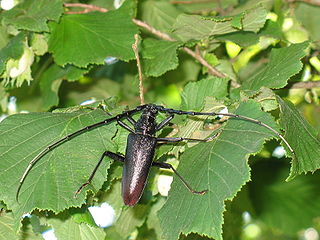
Cerambyx is a genus of beetles in the family Cerambycidae. They are commonly known as capricorn beetles, as their strong, stout and curved antennae, each segment of which flares towards the tip, are reminiscent of the horns of an Alpine Ibex or "capricorn".
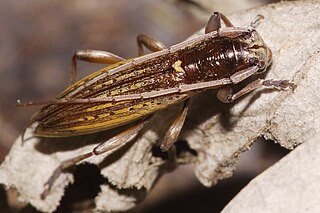
Xylotoles is a genus of flat-faced longhorns in the beetle family Cerambycidae. There are more than 15 described species in Xylotoles found mainly in New Zealand, Australia, and surrounding islands.
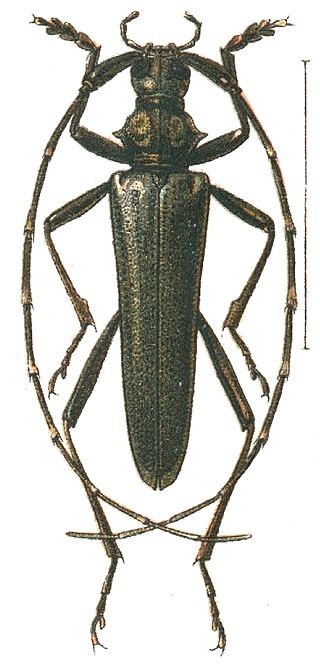
The Disteniidae are a small family of beetles in the superfamily Chrysomeloidea, traditionally treated as a group within the Cerambycidae.
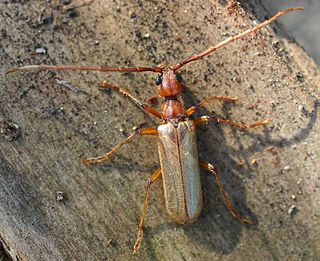
The Vesperidae are a small family of beetles, normally classified within the family Cerambycidae, of heterogeneous aspect but all characterised by larval stages related to roots of herbaceous plants or trees

Dorcasominae is a subfamily in the longhorn beetle family Cerambycidae. There are about 14 genera and more than 30 described species in Dorcasominae, found mainly in Asia and Africa. These genera are sometimes considered members of the tribe Dorcasomini, which would be the only tribe of this subfamily. This classification is in accordance with the TITAN Cerambycidae database, Catalogue of Life, and Photographic Catalog of the Cerambycidae of the Old World.. It is similar to that of Bouchard et al. in "Family-group names in Coleoptera", 2011.

Achryson is a genus in the longhorn beetle family Cerambycidae. There are about 17 described species in Achryson, found mainly in the Neotropics.

Bimiini is a tribe of beetles in the subfamily Cerambycinae, containing the following genera and species:

Mionochroma is a genus of typical longhorn beetles in the family Cerambycidae. There are more than 20 described species in Mionochroma, found in the Neotropics.

Coleoxestia is a genus of Long-Horned Beetles in the beetle family Cerambycidae. There are more than 50 described species in Coleoxestia, found mainly in Central and South America.

Criodion is a genus of Long-Horned Beetles in the beetle family Cerambycidae. There are about 11 described species in Criodion.
Plocaederus is a genus of Long-Horned Beetles in the beetle family Cerambycidae. This genus has a single species, Plocaederus bellator. It is known from the South American countries Brazil, Ecuador, Guyana, French Guiana, Paraguay, and Suriname.
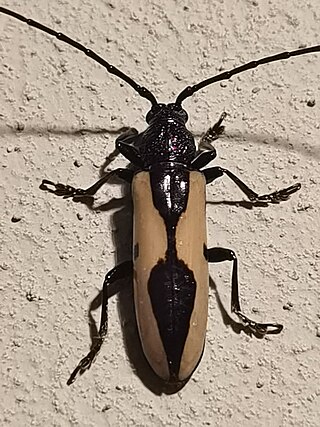
Poeciloxestia is a genus of longhorn beetles in the family Cerambycidae. There are more than 20 described species in Poeciloxestia, found in Central and South America.
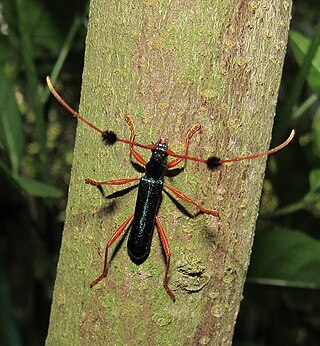
Compsocerus is a genus of typical longhorn beetles in the family Cerambycidae. There are about seven described species in Compsocerus, found in South America.

Pronuba is a genus of long-horned beetles in the family Cerambycidae. There are about five described species in Pronuba, found in Central and South America.

Curtomerus is a genus in the longhorn beetle family Cerambycidae. There are about 9 described species in Curtomerus.
Aleiphaquilon is a genus of Long-Horned Beetles in the beetle family Cerambycidae. There are about nine described species in Aleiphaquilon, found in South America.

Lautarus is a genus in the longhorn beetle family family Cerambycidae. This genus has a single species, Lautarus concinnus. It is known from southern Argentina and Chile.
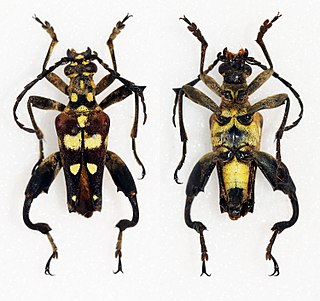
The Apatophyseini are a tribe of longhorn beetles erected by Lacordaire in 1869. They are placed in the monotypic subfamily Apatophyseinae.

















